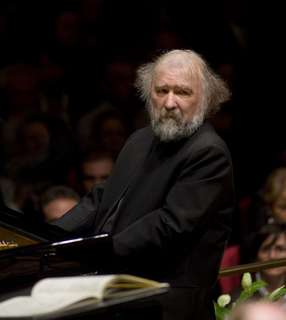|
Back
From Russia (and Hungary) with love Zurich
Tonhalle
11/18/2009 - & November 19*
Zoltán Kodály: Dances of Galánta
Béla Bartók: Piano Concerto No. 3, sz. 119
Pyotr Tchaikovsky: Symphony No. 4, op. 36
Radu Lupu (piano)
Tonhalle Orchestra, David Zinman (conductor)

R. Lupu (© Priska Ketterer)
Zoltán Kodály wrote his charming Dances of Galanta in 1933 to celebrate the 80th anniversary of the formation of the Budapest Philharmonic Society; it received its first performance under Ernst von Dohnányi. Galánta is a small area of Hungary on the old railway line between Vienna and Budapest, today part of Slovakia. Kodály spent an enjoyable seven years of his childhood there and would have heard the renowned Galánta gypsy ensemble. In 1800 a set of Hungarian dances were published in Vienna, among them some selected dances from “the Galantha gypsies”. This collection formed the basis for the main motifs of Kodály’s charming Dances from Galánta. Zinman brought out the brilliant orchestration and humour (shades of Kodály’s Háry János Suite) whilst allowing his players scope for instrumental virtuosity – special praise for the principal clarinet. These effervescent dances deserve a more frequent hearing.
The programme note gave us an interesting fact: when Bartók moved to New York in 1940, forced to leave his beloved Hungary, he moved to 3242 Cambridge Avenue in the Bronx. Over the road, at 3241 Cambridge Avenue lived the Zinman family, where a small boy, David, was then 5 years old. Little would either have known that David would one day take an especial pleasure in playing Bartók’s works in his later conducting career.
At a time when Bartók’s health was failing and he was short of funds, he wrote his Third concerto for his wife Ditta Pasztory. She was not as accomplished a pianist as her prodigious husband and the work is low on the raw percussive atonalities of his First concerto, or the bravura of the Second. Some critics say he wrote it in a style to be more acceptable to his American listeners. In any event there are many delightful melodic references to his old homeland and some shades of Bluebeard: sadly Bartók never lived long enough to hear it performed.
Radu Lupu sat at the piano, not on the usual piano stool but a chair with a tilting back and he leaned back to play the concerto as though driving a limousine. It was all so effortless, the notes tripped off his fingers, it was a joy to listen to. The Allegretto could perhaps have benefited from some more shading, but the chorale of the Adagio religioso was mellifluous. Lupu stressed both the tonal and structural clarity throughout; Zinman’s accompaniment was perfectly judged at all times. The last part of the Allegro vivace fairly raced off the final pages.
Tchaikovsky’s Fourth Symphony was written at about the same time as Brahms’ First Symphony, in 1876: Tchaikovsky was seven years younger than Brahms and the works could not be more different. Brahms’ First is in the grand old tradition with the giant Beethoven at its helm, Tchaikovsky’s a more refreshing and relaxed new musical culture. Tchaikovsky, in a letter to his compatriot composer Sergej Tanejew, drew parallels between his new work and Beethoven’s Fifth, not the musical content as such but the basic idea. The first notes played by the horns in fanfare and the bassoon contain the germ of the whole work: Tchaikovsky thought of it as indicating the power of sword of Damocles, dark Russian fatalism as in Dostojewski, unknown to Beethoven. Zinman took the opening quite slowly, preferring Swiss elegance and ensemble to Russian bite: more raw edge and white heat would have been appropriate. As the movement progressed, the movement settled and the final Moderato con anima was both rhythmic and dramatic, as required. It was a solid first movement, if not overly exciting.
Zinman phrased the Andantino beautifully, chose judicious tempi throughout, with plenty of dynamic shading. The strings enjoyed their pizzicato in the Scherzo, as did the trilling and thrilling woodwind and martial brass. And so headlong into the bombastic Final Allegro con fuoco and incendiary it certainly was. The brass blazed and Zinman moulded the last pages to its frenetic climax.
A most enjoyable concert.
John Rhodes
|